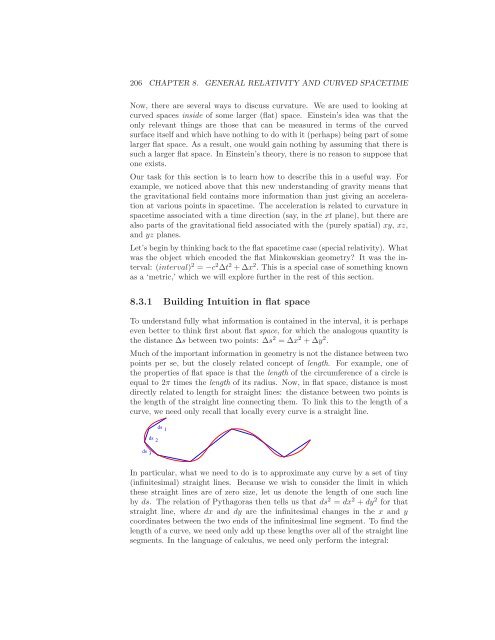Notes on Relativity and Cosmology - Physics Department, UCSB
Notes on Relativity and Cosmology - Physics Department, UCSB
Notes on Relativity and Cosmology - Physics Department, UCSB
You also want an ePaper? Increase the reach of your titles
YUMPU automatically turns print PDFs into web optimized ePapers that Google loves.
206 CHAPTER 8. GENERAL RELATIVITY AND CURVED SPACETIME<br />
Now, there are several ways to discuss curvature. We are used to looking at<br />
curved spaces inside of some larger (flat) space. Einstein’s idea was that the<br />
<strong>on</strong>ly relevant things are those that can be measured in terms of the curved<br />
surface itself <strong>and</strong> which have nothing to do with it (perhaps) being part of some<br />
larger flat space. As a result, <strong>on</strong>e would gain nothing by assuming that there is<br />
such a larger flat space. In Einstein’s theory, there is no reas<strong>on</strong> to suppose that<br />
<strong>on</strong>e exists.<br />
Our task for this secti<strong>on</strong> is to learn how to describe this in a useful way. For<br />
example, we noticed above that this new underst<strong>and</strong>ing of gravity means that<br />
the gravitati<strong>on</strong>al field c<strong>on</strong>tains more informati<strong>on</strong> than just giving an accelerati<strong>on</strong><br />
at various points in spacetime. The accelerati<strong>on</strong> is related to curvature in<br />
spacetime associated with a time directi<strong>on</strong> (say, in the xt plane), but there are<br />
also parts of the gravitati<strong>on</strong>al field associated with the (purely spatial) xy, xz,<br />
<strong>and</strong> yz planes.<br />
Let’s begin by thinking back to the flat spacetime case (special relativity). What<br />
was the object which encoded the flat Minkowskian geometry? It was the interval:<br />
(interval) 2 = −c 2 ∆t 2 + ∆x 2 . This is a special case of something known<br />
as a ‘metric,’ which we will explore further in the rest of this secti<strong>on</strong>.<br />
8.3.1 Building Intuiti<strong>on</strong> in flat space<br />
To underst<strong>and</strong> fully what informati<strong>on</strong> is c<strong>on</strong>tained in the interval, it is perhaps<br />
even better to think first about flat space, for which the analogous quantity is<br />
the distance ∆s between two points: ∆s 2 = ∆x 2 + ∆y 2 .<br />
Much of the important informati<strong>on</strong> in geometry is not the distance between two<br />
points per se, but the closely related c<strong>on</strong>cept of length. For example, <strong>on</strong>e of<br />
the properties of flat space is that the length of the circumference of a circle is<br />
equal to 2π times the length of its radius. Now, in flat space, distance is most<br />
directly related to length for straight lines: the distance between two points is<br />
the length of the straight line c<strong>on</strong>necting them. To link this to the length of a<br />
curve, we need <strong>on</strong>ly recall that locally every curve is a straight line.<br />
ds 3<br />
ds<br />
2<br />
ds<br />
1<br />
In particular, what we need to do is to approximate any curve by a set of tiny<br />
(infinitesimal) straight lines. Because we wish to c<strong>on</strong>sider the limit in which<br />
these straight lines are of zero size, let us denote the length of <strong>on</strong>e such line<br />
by ds. The relati<strong>on</strong> of Pythagoras then tells us that ds 2 = dx 2 + dy 2 for that<br />
straight line, where dx <strong>and</strong> dy are the infinitesimal changes in the x <strong>and</strong> y<br />
coordinates between the two ends of the infinitesimal line segment. To find the<br />
length of a curve, we need <strong>on</strong>ly add up these lengths over all of the straight line<br />
segments. In the language of calculus, we need <strong>on</strong>ly perform the integral:
















